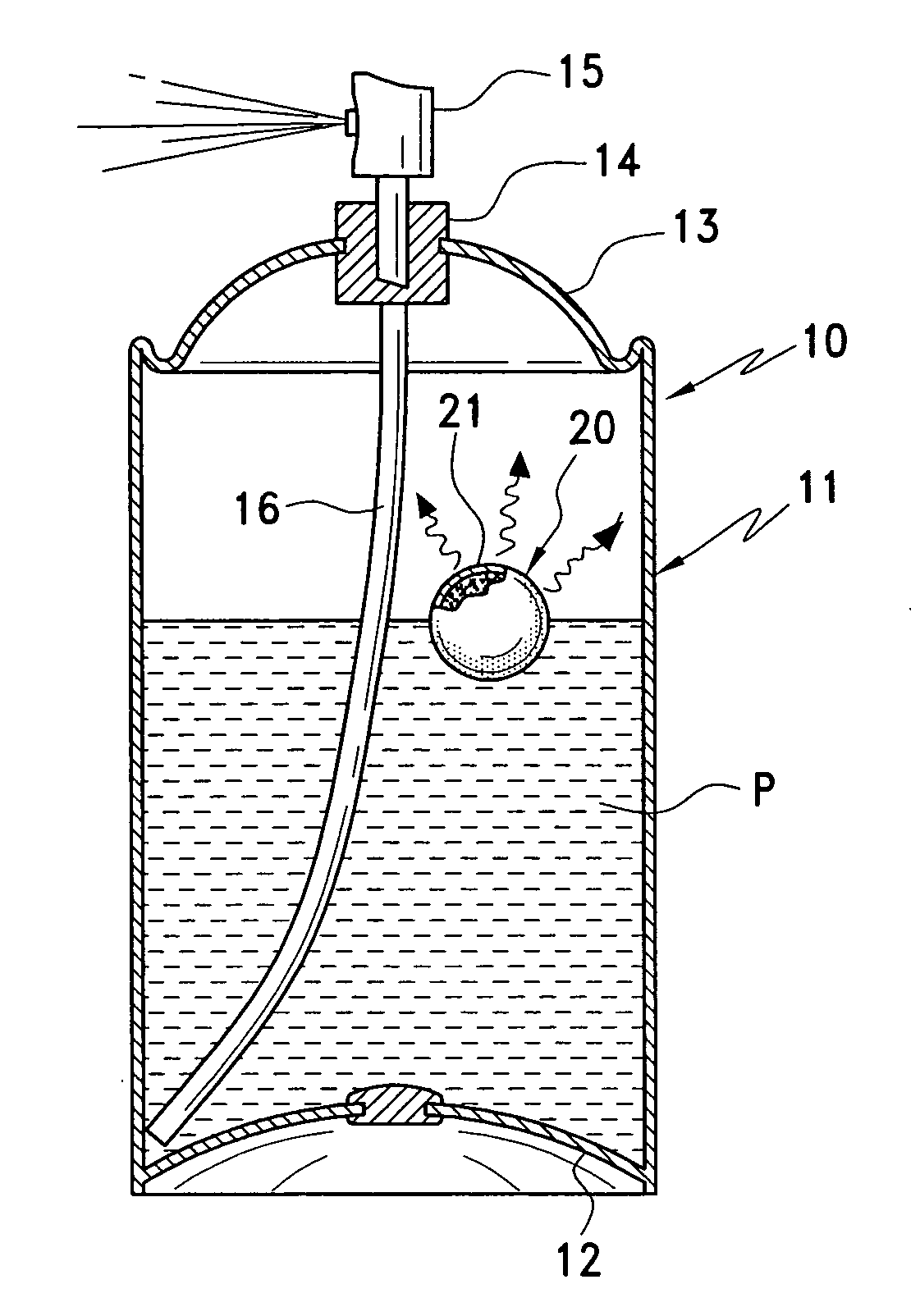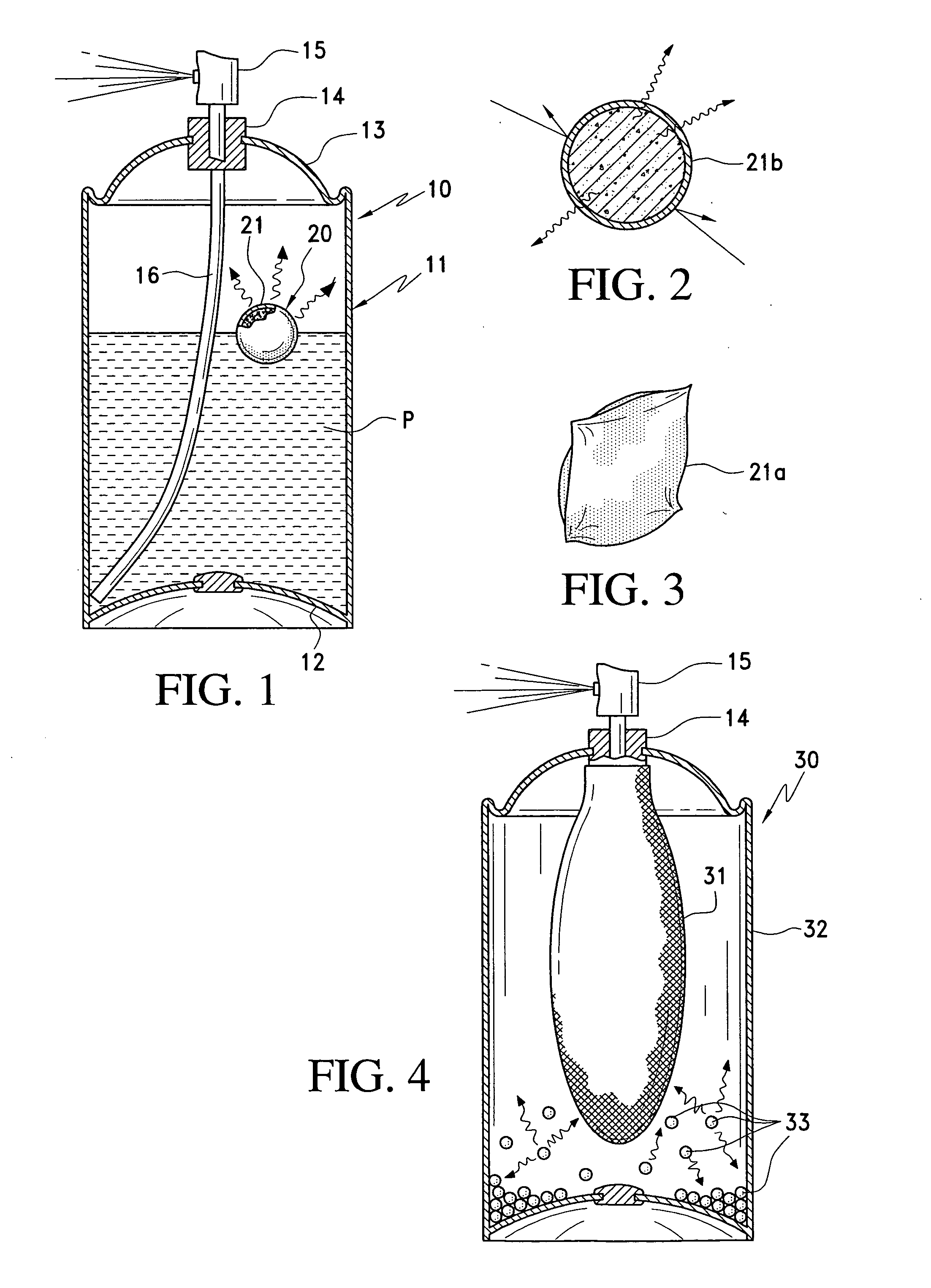[0026] The present invention provides a
system and method to replenish and maintain a desired pressure in pressurized containers such as
aerosol dispensers, pressurized beverage containers, or dispensers of the gas, such as, e.g.,
carbon dioxide fire extinguishers. In particular, the present invention provides an economical, efficient, and environmentally
safe system and method for providing a reserve supply of gas in a pressurized container. More specifically, the present invention provides a system and method for providing a reserve supply of gas to restore and maintain
propellant pressure as product is depleted from a container, wherein the gas is adsorbed or absorbed on a gas adsorbent or
absorbent material and means is provided to promote release of the stored gas from the
sorbent material.
[0032] While the foregoing systems perform better than prior art systems that do not store reserve propellant in a
sorbent, applicant has found that the quantity of gas desorbed (such as, e.g.,
carbon dioxide,
nitrous oxide, or
oxygen, and the like) is significantly increased when a polar
organic fluid such as ethyl
alcohol,
acetone, water, or the like, or combinations thereof, and / or a surfactant, is added to the sorbent material (e.g.,
activated carbon,
zeolite, or
molecular sieve material). If zeolite is used as the sorbent material, water alone is effective to promote release of the sorbed gas. The
polar fluid preferably is added in an amount sufficient just to wet the sorbent material. Alternatively, when the sorbent material is placed directly in contact with the product, a separate
wetting agent may not be necessary or desired if the product itself contains a polar
solvent, e.g., water or
alcohol.
[0033] Controlling the release of gas is dependent upon the ratio of the quantity of the polar
organic fluid to the quantity of sorbent material, and / or by varying the amount of sorbent material relative to the pressure in the container. Further control can be achieved by diluting the
polar fluid with water or a non-
polar fluid prior to adding the polar fluid to the container. Moreover, if the polar fluid is in gel form, it can take longer for the
active component to enter the sorbent material, thus controlling the rate of
desorption of the gas.
[0034] In a preferred embodiment the polar fluid comprises
alcohol diluted with water. The extent of
dilution can be selected dependent upon the desired results, but in a preferred embodiment the
dilution is 25% alcohol, i.e., one part by weight of alcohol to three parts by weight of water. Of course, the polar fluid could comprise 100% water, or any percentage of polar fluid, e.g., alcohol, or combinations thereof. Release of sorbed gas is more easily controlled when the polar fluid comprises water, but a quicker release of sorbed gas can be achieved when the polar fluid comprises alcohol or a similar material. When the sorbent material comprises activated carbon and is wetted with a polar fluid (e.g., a 25% solution of alcohol and water) at a ratio of 13% polar fluid to sorbent,
carbon dioxide release is increased by about 50% relative to conventional systems that do not wet the sorbent material with a polar fluid. Thus, in the system of the invention 90% or more of the sorbed gas is released from the sorbent.
Zeolite is particularly effective as a sorbent material, especially in barrier packs, enabling a lesser amount of sorbent to be used. For example, good results are obtained when ½ ounce of zeolite is used as the sorbent in a barrier pack system at 60 psi.
[0042] The use of activated carbon to adsorb additional gas in an
aerosol container can increase the available gas to a level that results in the pressure remaining more uniform until the product is depleted. This, in turn, maintains a more consistent, uniform and acceptable spray pattern from beginning to end because the pressure at the end is very close to the starting pressure. In some applications, release of make-up
gas pressure into the product may be desirable in order to better
aerosolize the product throughout the life cycle of the container, or to achieve better foaming, etc.
[0044] With the barrier pack
piston or bag-in-a-can system, CO2 gas can be charged into the product to a pressure lower than the pressure below the
piston or outside the bag, dissolving the CO2 in the product. This can be especially beneficial for some products, such as
hair spray, since the dissolved CO2 will aid in the break-up of the product when it is sprayed. It would also help reduce clogging of the
spray nozzle, for example, by resinous materials. That is, the extra propellant provided by the system of the invention provides benefits in addition to reserve propellant for discharging the product. With the gas storage system of the present invention, the pressure source chamber could be pressurized to 80-100 psig and the product chamber could be pressurized to 50 psig, for example, which pressures would be maintained until the product has been emptied, thereby maintaining a uniform spray pattern throughout the life of the container.
 Login to View More
Login to View More  Login to View More
Login to View More 


